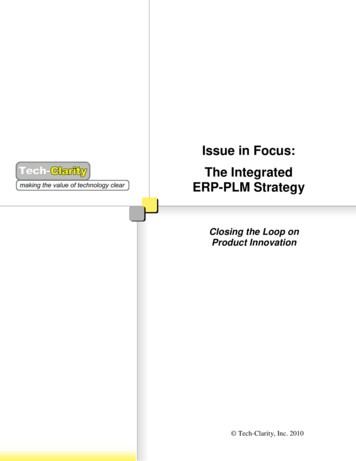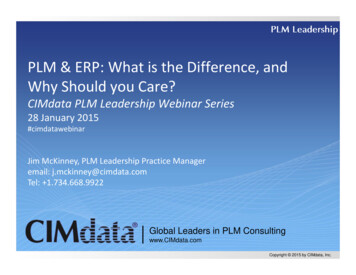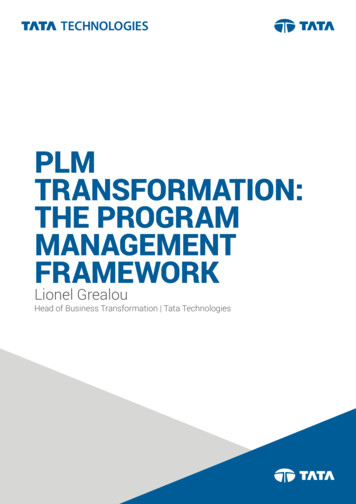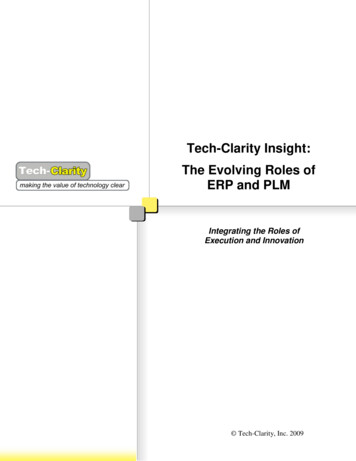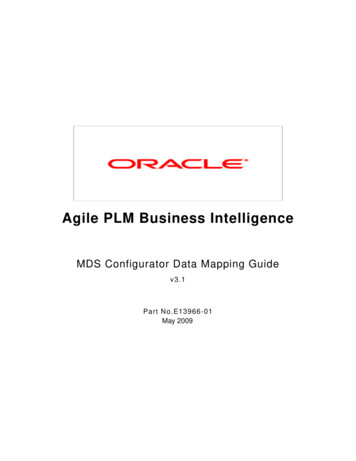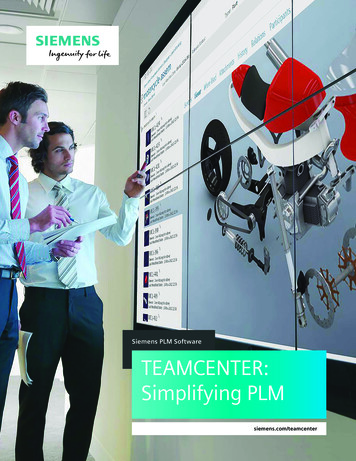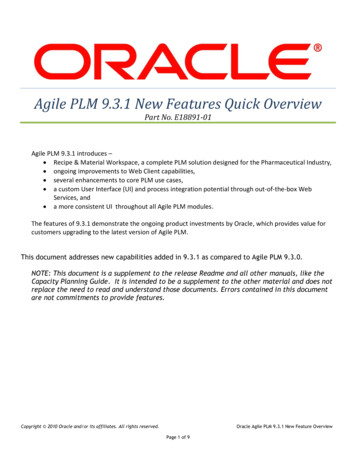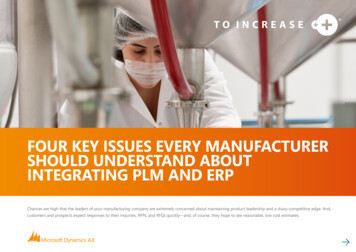
Transcription
FOUR KEY ISSUES EVERY MANUFACTURERSHOULD UNDERSTAND ABOUTINTEGRATING PLM AND ERPChances are high that the leaders of your manufacturing company are extremely concerned about maintaining product leadership and a sharp competitive edge. And,customers and prospects expect responses to their inquiries, RFPs, and RFQs quickly—and, of course, they hope to see reasonable, low cost estimates.AX
INTRODUCTIONAs your company grows and aims to becomeever more productive and competitive, itlikely streamlines its processes and practicesfor the development, design, and revision ofproducts on one hand and the activities involvedwith manufacturing, procurement, distribution,sales, and marketing on the other. Businesscritical software systems help you in that effort,most prominently product lifecycle management(PLM) and enterprise resource planning (ERP)systems. Typically, these systems replace anumber of more limited software tools and resultin increasingly efficient processes.CONTENTSIn this paper, we take a look at what PLM is and howit can be of value to you. Because PLM deployment isinseparable from the question of whether to integratePLM and ERP, we also: Present the main arguments for PLM and ERP integration Highlight the potentially far-reaching and highly beneficial consequences of PLM and ERP integration Discuss a number of important process-related andorganizational considerations you need to keep inmind Showcase the actions you can take to resolve thequestion of PLM and ERP integration in your business.2
CONTENTSUnderstanding product lifecycle management. 3PLM and PDM. 4The PLM and ERP integration conversation. 5Overcoming organizational, information-related, competitive, and cultural limitations. 5Benefits of shared data and closer interdepartmental collaboration. 6Planned and unforeseen consequences of ERP and PLM integration. 6Process adjustments and continued relevance for IT. 7Real-life integration success experiences. 7What should manufacturers do?. 9Create your own integration. 9Purchase a standard integration. 9The complex case for doing nothing.10Implications to consider.10A stand for strong standards.12Next steps.12CONTENTS3
UNDERSTANDINGPRODUCT LIFECYCLEMANAGEMENTIt is in the nature of PLM to span across thedepartments and processes that are involvedwith products. Those include marketing,design, engineering, manufacturing, qualityassurance, and others. However, practicallyand in a great number of companies, PLM isfirmly rooted in the design and engineeringdepartment, and the processes that relateto these functions. Typically, the design andengineering managers are also in charge of thecompany’s choice of a PLM system, and theirdecisions will most strongly consider the needsof their teams.CONTENTS4
Leading PLMvendorsMany software providers provide PLMsystems or a subset of the functions youwould expect to find in a PLM solution. Someof these companies have their origins in computer-assisted design (CAD) or computer-assisted engineering (CAE) solutions, which areoften used in companies’ design and engineering organizations. That has given thema natural segue to PLM. Some PLM providerssupport a particular type of business or market segment with its very specific requirements for PLM software.Depending on your industry perspective andhow your definition of the PLM market, youmay think of the leading vendors differentlythan we do. In our experience, there are threeimportant, well-known software providersthat provide end-to-end PLM solutions whichhave found adoption around the globe: PTC with Windchill Siemens with Teamcenter Dassault with EnoviaCONTENTSPLM does not necessarily require software, and youmay be able to perform PLM in your operation without deploying a special software tool to accomplishit. But, for most people, PLM is firmly associated withsoftware solutions which provide that product information backbone. For the purpose of this paper, wewill consider PLM in terms of software solutions.The vendor-neutral PLM Technology Guide gives asolid introduction into the thinking behind PLM andthe considerations companies need to keep in mindwhen they select PLM systems. In assessing therelevance of PLM, the PLM Technology Guide’s writers note, “The importance and value of PLM variesthroughout the lifecycle of a product. It is most important from ideation to product launch, i.e. duringthe development and design of a product, and haslower importance between product launch and theend of production, i.e. during manufacturing anddistribution, when ERP takes over the dominant role.Finally PLM gains a little more importance again inproduct support and maintenance.”PLM and PDMOften, the terms “PLM” and “product data management” (PDM) are used interchangeably. Otherwriters may consider PDM as a subset of PLM thatis equivalent to version control. In the context ofthis paper, we visualize PLM as a cross-system andinterdepartmental discipline that may be rooted inengineering and design, but that shares and col-lects data from a variety of other systems and withother teams. PDM, in comparison, is a more engineering-focused practice whose main purpose is therelease of product data.Practically, the distinctions between PLM and PDMmay depend on the capabilities of the software solutions you use, how well they fit your business, andhow well they have been implemented. An advanced PDM system, for example, may well support acomplex change management process and will needto share data with the ERP system as much as anyPLM solution. For some readers, it may make senseto substitute “PDM” for “PLM” in this paper, giventheir PDM practice.Defining PLMPLM “is the process of managing the entire lifecycle of a product from inception,through engineering design and manufacture, to service and disposal of manufactured products. PLM integrates people, data,processes, and business systems and provides a product information backbone forcompanies and their extended enterprise.”5
THE PLM ANDERP INTEGRATIONCONVERSATIONBecause companies that use a PLMsystem typically also have ERPsystems, the debate as to whatextent PLM and ERP should beintegrated is inseparable fromhaving deployed these software tools. Thetechnical feasibility of the integration andsubsequent data exchanges between ERPand PLM systems is a relatively minor concerncompared to organizational, cultural, andprocess considerations.CONTENTS6
Overcoming organizational, information-related, competitive, and cultural limitationsCommonly, the ERP perspective will be to strengthenand extend ERP by connecting it with the company’sother software resources. Design and engineeringgroups using the PLM system may not necessarilybe sold on this kind of integration, which can behighly consequential for their processes and theway they work. Traditionally, design and engineeringin many companies is used to a high degree ofautonomy. This can lead to a silo mentality thattends to hold the company back and preventspeople from collaborating effectively. When, assometimes happens, design and engineering teamsreport to their own vice president and so does themanufacturing organization, the gulf between thetwo widens yet more.To make sense of a PLM and ERP integration effort,businesses need to look beyond the data movingbetween the systems. They also have to considerrevising and connecting the business processes thatinvolve engineering and operations. If data sourcesconnect, it no longer makes sense for people towork in an isolated manner. What will it mean forengineers’ effectiveness to be able to draw onproduction data from the ERP system, and how willAn integration of PLM and ERP can make ahuge difference in terms of making it easierto respond to evolving market needs andmanage change, and that involves feedingPLM data smoothly into engineering andmanufacturing bills-of-materials.CONTENTSit impact manufacturing planning and operationsif PLM and engineering data feed directly into theERP system? And, to what extent do individualcontributors manipulate and revise data based ontheir research, expertise, and understanding of thecompany’s goals and markets, before transferringthem from PLM into ERP or the other way? What willhappen to the value these employees create throughtheir activities, and how can companies ensure thatthis contribution does not fall by the wayside?cross-organizational processes.An integration of PLM and ERP can make a hugedifference in terms of making it easier to respond toevolving market needs and manage change, and thatinvolves feeding PLM data smoothly into engineeringand manufacturing bills-of-materials. An articleon Engineering.com points out how disconnectedPLM and ERP systems result in data errors whenengineering BOMs originate in the PLM system andmanufacturing and service BOMs in the ERP system:“Ashley Morris, a researcher at Cardiff University inthe UK, has identified seven root causes of productdata errors. The three most important ones are 1.Inaccurate data entry; 2. Incorrect data flow betweenapplications; 3. Duplicate data between systems.Product development teams are all-too-familiar withhow these errors occur given the various systems thatmanage the data.” Aberdeen Group states, “Whattruly separates the best-in-class when it comes tomanaging change in the business is in the transferand management of the ebom and mbom.” When you share information among your backend ERP system and your engineering teams,your quotations can become more accurate. Youmay make more effective use of products andcomponents that already exist or are on hand ininventory, which can help reduce inventory levelsand cut engineering times. You may well be ableto shorten the time it takes to gather engineeringchanges for an upcoming product release andtransfer them to manufacturing. Also, engineerscan access comprehensive information within aconnected system on their own, and no longerneed to search for it in a separate resource thatthey may be unfamiliar with or to which they maylack access, requiring them to enlist somebodyelse’s assistance. When it comes to process changes, integrationof PLM and ERP systems makes it possible tointroduce new products faster. A sustainedfeedback loop from manufacturing and serviceto engineering and development can ensure thatall relevant input is considered in product designand revisions. When traditional silos betweenthese departments are removed, design can earlyon incorporate input from manufacturing to helpreduce production costs and increase productquality. This results in less time spent on re-workand re-engineering, and fewer change ordersfollowing a product release.Benefits of shared data and closerinterdepartmental collaborationIn our experience, the potential benefits ofintegrating ERP and PLM systems fall into two main,inseparable categories—the advantages of sharingdata, and those related to implementing shared,Planned and unforeseen consequences of ERPand PLM integrationHaving said that, are there any detriments tointegrating ERP and PLM systems? Maybe thereare no disadvantages as such, assuming that theintegration and data exchange work flawlessly7
Engineering and production teams have tocarefully negotiate how they want to manage the unexpected consequences of engineering or production decisions.and people take advantage of more collaborativeand efficient ways of working together. No doubtthere are resource and cost issues in acquiring andmaintaining an integration. If those are handled ina satisfactory manner, the drawbacks of ERP andPLM integration depend very much on how wellcompanies and their people manage the cultural andoperational changes that come with this integration.For example, if you imagine a company whoseengineers are used to turning out the best possibleproduct designs and simply passing them on tomanufacturing for production, an ERP and PLMintegration will introduce new relationships anddependencies. The engineering and manufacturingrealms will have to understand and respect eachother’s processes, expertise, and data limitations.Engineering and production teams also have tocarefully negotiate how they want to managethe unexpected consequences of engineering orproduction decisions. For instance, the PLM systemmay predefine a master data element, such as aproduct group, which in turn impacts general ledgersettings in the ERP system. Changing this value canmake great sense from a PLM perspective, but mayimpact ERP and the operations side of the house inunforeseen ways. If the integration itself is well built,there may be no immediate issues at a technicalCONTENTSlevel, but engineers and manufacturing managershave to understand and consider the dependency,which may mean giving up some flexibility. Inaddition, software upgrades and other changes inthe ERP or PLM system may be consequential for theintegration itself, which may or may not continue toperform as it should.Process adjustments and continued relevancefor ITThe processes surrounding the PLM and ERPintegration also need to be structured to ensurebi-directionally that technology users on themanufacturing and the engineering sides areaware of product changes. In a sequence wheremanufacturing updates product information based ona change implemented during production, and thatrevised information is available to product design,where engineers incorporate it into a new productrevision, manufacturing managers also need to beaware of that new revision, so the manufacturingoperation does not revert to the earlier versioninadvertently. Without this closed loop, errors canresult in needless expenses, wasted resources, andproducts that are not acceptable to customers. TheFor the IT managers in many companies,ERP and PLM integration has a low priorityonce the fundamental systems are in place.But the liability that may arise if IT is notspearheading the integration is that it misses an opportunity to move the businessforward and transform the ways peopleand processes work.more product versions there are, the greater thepotential fallout from process disconnects.For the IT managers in many companies, ERPand PLM integration has a low priority once thefundamental systems are in place. The availablebudget may be small and the sense of urgencylimited, also because it may appear that theintegration would add more complexity andchallenges to IT management. But the liability thatmay arise if IT is not spearheading the integrationis that it misses an opportunity to move thebusiness forward and transform the ways peopleand processes work. When people work aroundinstead of with IT to answer such questions as whatthe price of a purchased component is or what theengineering group’s schedule is for delivering thenext version of a flagship product, IT risks diminishingits relevance and future budget allocations.Real-life integration success experiencesThe important thing to keep in mind is that anunhindered flow of information resulting froman ERP and PLM integration can make theinteraction and collaboration between engineeringand manufacturing, procurement, inventorymanagement, distribution, sales, and marketing moreefficient and effective at the same time. Examplesabound from the experience of companies that didintegrate ERP and PLM. Relatively minor changes canhave a significant, positive impact when people inthe company’s teams work with the same data andinformation is shared in real time across systems anddepartments. For instance, engineers can see at any point inthe design process what the contract pricingfor a product or component is when sourcedfrom a company-preferred vendor. They no longer8
need to send an email to somebody in purchasingand wait several days for a response to it. When engineers detail a sub-assembly structure,they can send a skeleton version of thestructure to procurement, where teammembers can start the negotiations withpotential vendors early. Procurement relies onthe same, current data that engineers provided.There are no more excuses for errors anddisconnects because somebody is using an out-ofdate product spec. During the revision of a product, engineers gatherall relevant data, including updated assemblyinstructions and changed drawings. Then theymove through their approval workflow to ensurethat, from the engineering perspective, the bestpossible product change takes place. At the sametime, sales receives an automated warning topoint out that—just to name an example—thereCONTENTSare five open orders affected by this change,whose consequences need to be considered.Materials managers, on the other hand, noticethat there are seven inventory items related tothe product spread across two different sites,from where they need to be phased out first. Allof the stakeholders working together canmake sure that a planned product change isrealized in the most efficient manner from alogistical perspective. CRM can become more useful in productchange workflows. When customers ask for achange in the features of a product component,engineers will need to capture updatedrequirements from the CRM system. They can thenupdate the product design and the affected partsof the product structure. Those product designupdates, in turn, transfer into the CRM system,where they are flagged as pre-release updates toan existing quote. Once that revised quote hasgone through the company’s approval workflow, itcan be sent to the customers for their review andapproval.These are just some examples of relatively smallchanges that are possible when people look at thesame set of data and information is shared in realtime across systems and departments. Many otherpossible improvements can take the form of costoptimization, less re-work, no unplanned scrappingof outdated stocks, and other benefits. However,many companies will not improve their efficiencyalone, but can also become more effective. Forexample, they may produce and submit competitivebids faster, always provide accurate and currentdata to field service engineers, and experience otheradvantages.9
WHAT SHOULDMANUFACTURERS DO?Now that we have considered thepotential advantages and otherconsequences of ERP and PLMintegration, what is the bestrecommendation for manufacturers?They have several options. They can buildtheir own bespoke integration, or purchase anexisting product that they can install with minoradjustments. Finally, they may find it justifiable toforego an integration entirely.CONTENTS10
Create your own integrationA custom integration is often seen as the last resort,but you may have good reasons to go this route.It may be your single option if your ERP or PLMsystems are not widely adopted products or weredeveloped in-house, and no standard integrationexists. Your IT group or contractors you hire cancreate an integration that works excellently withinyour processes and business model, and thatprovides exactly the capabilities you need. You don’tinvest in features that may be relevant to many othercompanies, but not to yours. However, upgradesand enhancements will also be realized in the samebespoke approach, so there is an ongoing resourceissue to resolve. Depending on the nature of yourcompany and the products you develop, there maybe an advantage in not sharing any details regardingyour ERP and PLM integration with outside parties.Purchase a standard integrationAn off-the-shelf integration can be a great fit if boththe ERP and the PLM systems are standardizedproducts based on common technologies. SomeERP and PLM vendors provide such integrations, andthere are also integration providers who sell neitherERP nor PLM systems. From an administrative ITperspective, a high-quality, standard integration mayhave very low demands when it comes to keeping itcurrent and running, and interoperability-related andother problems may be very few. However, with theacquisition of a standard integration you may incur anew or increased dependency on a software provider,so there are consideration’s regarding that company’sviability and long-term ability to support the solutionin your business.A standard integration may give you most, butnot all of the capabilities you look for. CompaniesCONTENTSFrom an administrative IT perspective, ahigh-quality, standard integration mayhave very low demands when it comesto keeping it current and running, andinteroperability-related and other problemsmay be very few.have several ways of dealing with such limitations.Some adjust their processes accordingly, whichmay not make users happy and may not be veryeffective. Sometimes, they share data manuallythrough spreadsheets or in other ways outsideof the integration, which may defeat the purposeof deploying the integration in the first place. Or,they customize the integration to their operatingrequirements. If such customizations are extensive,maybe an integration specifically built for thecompany makes more sense.The complex case for doing nothingLet’s keep an open mind: It may be the case thatERP and PLM integration is simply not somethingyour company needs. If that is so, you don’t need topurchase additional software, deploy it, and keep itcurrent. But you need to be aware of the potentialimplications in terms of risk, effort, effectiveness, andfuture viability: Risk. In the absence of an ERP and PLMintegration, how likely is it that an outdatedproduct drawing or specification makes it intoproduction, and what would the impact be?Are product changes clearly traceable anddocumented? Can you reliably and efficientlycomply with the regulatory and qualityrequirements your public- or private-sectorcustomers present? Effort. If PLM and ERP are not integrated, howdoes information get from one operational areainto any of the others, and what are your processesfor ensuring its accuracy? How much redundantdata entry or process redundancy does this cause,and what is the likelihood of errors that needto be corrected? What are the costs of reworkand hidden changes that can become necessaryafter a product has already been released tomanufacturing? Effectiveness. How does the lack of ERP andPLM integration impact the business’ abilityto compete and grow, and adjust to changingmarkets? Without the integration, will time-tomarket for new and updated products increase,and what does that mean for the company’scompetitiveness? How will the company be able torespond when customer requirements change? Future viability. Given that an integration ofERP and PLM is not essential today, what will itbe like three or five years out, when the companypursues its current strategy successfully? Will thatintegration still be something the business caneasily do without? Will IT’s vacating of leadershipin the area of systems integration cause it to beperceived as a business enabler, a road block inthe way of the company strategy, or a reminder oflost opportunities?If these considerations are irrelevant, integratingPLM and ERP and achieving an automated exchangeof information between them, is probably not astrong priority for your business. If they strike youas meaningful, considering your active integrationoptions may be the better way to go.11
Implications to considerThere are some other considerations to keepin mind as you think about the promise andpotential of an ERP and PLM integration inyour company: Process improvement opportunities.As we already mentioned, ERP andPLM integration can have significantimplications for the way processes andteams work together, far above simpledata-sharing. More than likely, closeintegration of systems used by formerlyseparate departments will impact crossdepartmental processes and workflows,and call traditional boundaries betweenbusiness groups into question. IntegratingERP and PLM, thus, presents anopportunity to revise these processes andensure they serve the company today andin the future. Data quality. Before you go aheadwith an integration, verify the quality ofthe data that reside in the PLM and ERPsystems. There may well be steps youcan take to cleanse data and improve itsquality before you connect the systems,and the results of the integration will bemuch the better for it. Automations. If, within the differentbusiness groups in the company, teamshave long relied on their own, standalone systems—such as PLM, CAD, andothers in engineering, or ERP and CRMfor logistics and sales—intradepartmentalautomation may be very high, and withinthe individual lines of business certainCONTENTSefficiencies may be excellent even ifprocess disconnects result in an overall,companywide lack of efficiency. It’sworthwhile reviewing such automationsto find ways to maintain their positivecontribution, if necessary with redesigns. Ownership. Organizationally, you wantthe business stakeholders from theengineering, manufacturing, procurement,sales, distribution, and other teams tobe involved in defining and preparingan important integration that can be asconsequential as ERP and PLM becomingconnected. If IT alone drives the projectwith minimal stakeholder participation,organizational gravity may outweigh thebenefits of the integration or prevent themfrom being fully realized in the first place.In the best-case scenario, your IT roadmapand the company strategy are fully in sync,and the ERP and PLM integration makesbest sense from a business-strategic aswell as from an IT-tactical perspective.In some large enterprises, there may bemultiple instances of ERP and PLM systems,and all possible integration scenarios we justdescribed may make sense. Some globalcompanies very successfully follow a varietyof IT and business strategies in distinctregions and markets, and others work towarda universal integration with companywidestandards for ERP, PLM, and other systems.This goes outside the scope of our whitepaper.12
A STAND FORSTRONG STANDARDSAs you see, integrating ERP and PLM, which mayon the surface be a common-sense, if not simple,undertaking, is highly complex and not the same forevery company. It also presents rich opportunities forincreased organizational productivity and valuableprocess improvements. We tried to point out someof the most critical considerations as you think aboutintegrating PLM and ERP.Most To-Increase customers, companies that usestandard ERP systems such as Microsoft Dynamics AX,are in favor also of standardized integrations betweenERP and PLM systems. For that reason, we offerproductized integrations between Microsoft DynamicsAX and two very widely adopted PLM systems, PTCWindchill and Siemens Teamcenter. Outside of theseCONTENTSsolutions, To-Increase provides the framework andhas the expertise to integrate almost any other PLMsystem or other conceivable software tool with theERP system.If you consider off-the-shelf integrations, keep inmind that some of them are designed as pointintegrations and impose significant limitations whencompanies look for interdepartmental changemanagement across processes. Other products,however, may be more versatile and configurable.As with any significant technology investment, it paysto perform your due diligence, talk to the existingcustomers of software providers, and performthorough, detailed comparisons.Next stepsIf you want to discuss ERP and PLM integration, orhave feedback and questions, we would love to hearfrom you. Please send me a note athvanderidder@to-increase.com. Take a look at our standard integrations withPTC Windchill and Siemens Teamcenter, both forMicrosoft Dynamics AX. Connect with us on Twitter, Facebook, Google ,and LinkedIn. Watch solution demo videos on theTo-Increase YouTube channel. Contact To-Increase.13
Contacte-mail addresslearnmore@to-increase.comThe Netherlands (HQ)To-Increase B.V.Kazemat 23905 NR VeenendaalThe Netherlandsphone 31(0)318 531 900fax 31(0)318 531 901EuropeTo-Increase CorporateKazemat 23905 NR VeenendaalThe Netherlandsphone 31(0)318 531 900CONTENTSNorth AmericaTo-Increase600 Cordwaïner DriveNorwell, MA 02061United Statesphone 1 866-874-0856AsiaTo-IncreasePlot No. 564/A39Road No. 92, Jubilee HillsHyderabad - 500033IndiaMicrosoft Dynamics AX is a trademark of Microsoft CorporationThe To-Increase Logo is a registered trademark of To-Increase BV.The information contained in this document represents thecurrent view of To-Increase B.V. on the issues discussed as ofthe date of publication. Because To-Increase must respond tochanging market conditions, it shoul
PLM and ERP, we also: Present the main arguments for PLM and ERP inte-gration Highlight the potentially far-reaching and highly be-neficial consequences of PLM and ERP integration Discuss a number of important process-related and organizational considerations you need to keep in mind Showcase the actions you can take to resolve the


